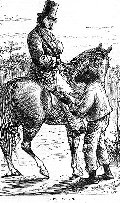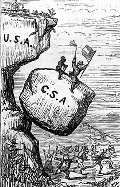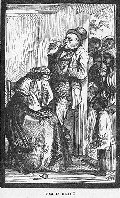Thomas Nast
Today, a cartoonist fights City Hall -- and wins. The University of Houston's College of Engineering presents this series about the machines that make our civilization run, and the people whose ingenuity created them.
Thomas Nast, the father of American political cartoons, was born in Germany in 1840. He came to New York when he was six. At 12, Nast quit public school to study art. By the age of 20, he was working for the New York Illustrated News. They sent him off to cover a prize fight in England. From there he went to Italy and did free-lance drawings of Garibaldi's Revolution.
Harper's Weekly Magazine made Nast a Civil War correspondent in 1862. Now his peculiar art began taking shape. He strongly supported the Union cause. But his pictorial reporting transcended side-taking. He began showing the carnage and sadness that follows war, more than horse and cannon in battle.
Still, Ulysses Grant later said that Nast had done as much as anyone to preserve the Union, and Lincoln called him his "best recruiting sergeant." Great artists like Winslow Homer were also out in those fields of slaughter, but Nast began doing what they didn't. His art was becoming a vehicle for commentary. His pictures reflected, more and more, what he felt -- rather than what he saw.
Nast underwent a transformation. He'd gone out as an illustrator. He'd come back as a political cartoonist. Cartoons were an English weapon that America had yet to master.
Of all Nast's causes, America can best thank him for what he did in 1871. An old patriotic organization called the Tammany Society controlled New York. It was run by the infamous William Tweed and three shrewd cronies.
No one did business without paying bribes to Tweed's gang. They bled huge sums of money from citizens. Their theft ran up a debt New Yorkers were still paying well into this century.
So Nast went to work. Tweed wasn't worried about what the papers wrote. Few of the people he was robbing could read, anyway. But Nast created a whole new visual vocabulary of political assault -- Tweed's thumb lowered on New York City, Tweed with a sack of money for a head, Tammany underlings portrayed as slaves.
A Tammany agent finally showed up and offered Nast $100,000 for a long art-study trip to Europe. Nast refused, and the offer rose. When he turned down a half million dollars, they threatened his life instead. Nast held on. He succeeded in bringing legal processes to bear on Tweed and his gang. Within months they were all either in jail or on the run.
A man of conscience had forged a new tool. Now he applied it to other causes -- like equal rights for freed slaves. He'd written a new language of visual simplification. That language would not only transform politics. It was, for better and for worse, on its way to transforming the American mind as well.
I'm John Lienhard, at the University of Houston, where we're interested in the way inventive minds work.
(Theme Music)
St. Hill, T.N., Thomas Nast: Cartoons & Illustrations. 117 Works, New York: Dover Publications, Inc., 1974.
Keller, M., The Art and Politics of Thomas Nast. New York: Oxford University Press, 1968.
Paine, B.A., Thomas Nast: His Period and His Pictures. Princeton: The Pyne Press, facsimile of the 1904 edition.
Two books illustrated in part by Nast:
Shaw, H.W., The Complete Works of Josh Billings. New York: M.A. Donohue & Co., 1919.Pullem, C.H., Miss Columbia's Public School. New York: Books for Libraries Press, 1969, reprinted from the 1871 edition. (This book continues the attack on Tweed and Tammany Hall.)
I am grateful to S. Dileep and N. Shamsundar for calling Nast to my attention as the possible subject of an episode and for providing a copy of the St. Hill source.

 .
. 
Images courtesy of Special Collections, UH Library
Click on the thumbnails for full-size images of Civil-War era Nast cartoons
Illustrations by Thomas Nast for Inside: A Chronicle of Secession, 1866.